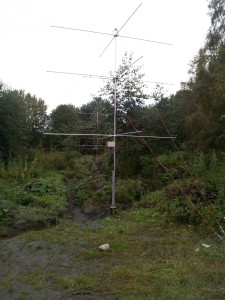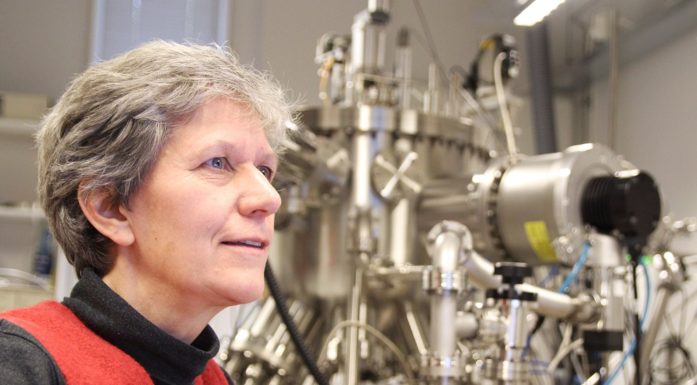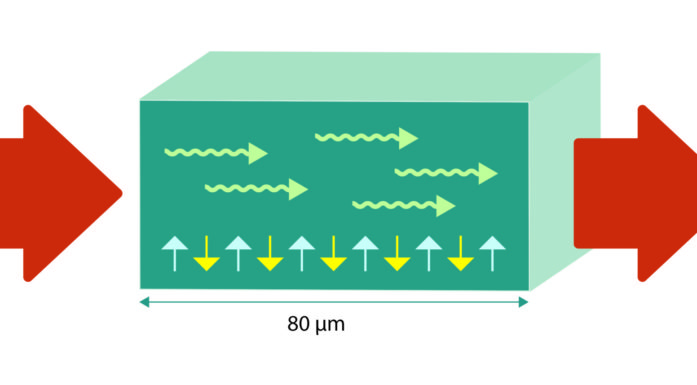Studying shooting stars helps improve weather forecasting
Using devices that look like old-fashioned TV antennae, physicists at NTNU are improving weather forecasts by studying shooting stars in the upper atmosphere.
“By better understanding how the atmosphere works, we can create longer-term weather forecasts that are much more accurate,” says Rosmarie De Wit, a PhD candidate at NTNU’s Department of Physics. Her research looks at the weather all the way up to the edge of the atmosphere, on the edge of space.
Watch Rosmarie De Wit explain her research:
The secret is in the tail

Researchers use antennae to measure how the tail of a shotting star behaves, which gives them a great deal of information that can improve weather forecasts.Photo: Daniel Skåre
De Wit is really interested in the temperatures and winds in the highest parts of the atmosphere. But sending instruments so high in the sky is costly and difficult. So de Wit uses natural phenomena to help her understand what is going on, by observing the trails that shooting stars leave in the atmosphere. She’s not studying the big shooting stars that we see in the night sky from down here on Earth, but ones that are much too small for the naked eye to see. The advantage is that there are plenty of them.
Shooting stars are actually meteors, which, upon reaching a distance of about 80-100 km from the Earth’s surface, meet so much air resistance that they begin to burn up. As they burn, they grow tails of electrically charged particles.
“We use the antennae to measure how meteor tails act, which gives us a lot of information about the weather,” de Wit explains. “The tails of shooting stars are like the contrails you see behind airplanes. At first they’re thin, clearly defined lines, but over time, they spread out and dissolve. The same thing happens to meteor tails.”
Predicting winter weather in Norway
The winds and temperatures in the upper atmosphere affect the weather close to the ground, but not right away. The clouds, storms, and rain we experience on Earth are limited to about 10 km above the ground, while de Wit studies the weather that is found at 100 km above the Earth’s surface.
The models that meteorologists currently use don’t include data from this altitude in simulations, meaning that the effect of weather in the upper atmosphere on the weather near the Earth is excluded from their equations, making their predictions less accurate and not as long term.
The reason for this is because measuring weather in the upper atmosphere is quite complex. As you go higher up, you have to take into consideration an increasing number of different processes in different layers of the atmosphere.
“This is exactly what I’m studying. By better understanding the processes that are happening way up high, we can make our models much more accurate,” explains de Wit. “If we can predict the weather farther into the future, we may be able to predict the intensity of autumn storms, or if we’ll have a cold winter in Norway.”
“Naturally, this is useful for the general public, but it’s especially good for companies that produce and sell electricity, or for employees on oil platforms in the North Sea,” she says.
Information from signals
To measure the behaviour of meteor tails and the particles they contain, de Wit uses radio waves.
“We send out radio waves, which hit particles in meteor tails and come back as signals that are picked up by our radar,” she says. “This gives us information about how the tails move, and how long they take to dissipate.”
de Wit then compares the observations she has made of the actual weather 100 km up in the atmosphere to models that predict future weather patterns, and what they calculate the weather should be like at the same time. This allows her to check the accuracy of her models.

“The fun thing about physics is, you can look out the window and explain everything you see,” NTNU PhD student Rosmarie de Wit says. “Why the sky is blue, why clouds move the way they do, why the weather is the way it is right now.” PHoto: NTNU
“Sometimes it makes sense, other times it doesn’t,” she says. “When it doesn’t make sense, I try to find out what has happened up there that the model didn’t include in the simulation.”
Not quite according to plan
Rosmarie de Wit is 26 years old, and originally from the Netherlands. She began her doctorate in physics at NTNU in January of 2012, and will be finished at the end of 2014. However, this isn’t her first time in Norway.
“When I was 15 or 16, I went on vacation with my family to Tromsø. We visited the university museum and saw an exhibit about the northern lights,” she says. “I found it to be incredibly interesting, thought ‘this is what I want to study!’, and now, ten years later, here I am, but in Trondheim. I’m a little south of Tromsø on the map, and studying phenomena that are about 40 km below the northern lights in the atmosphere. So that’s how it ended up!”




